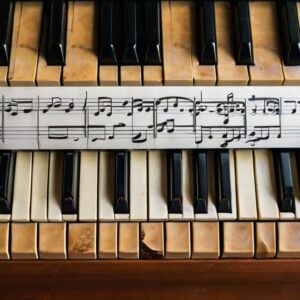Classical music, often seen as the pinnacle of musical artistry and the keeper of musical tradition, has found itself intertwined with the latest digital technologies. This merging has transformed every aspect of how we create, share, and experience the timeless works of Mozart, Beethoven, Bach, and many others. From the rise of streaming platforms to the advent of virtual reality concerts, the classical music scene is buzzing with innovation, presenting both challenges and opportunities for artists and audiences alike.
Digital Instruments and Software

Gone are the days when producing classical music was solely the realm of grand concert halls with large orchestras. Now, composers and musicians can create complex, high-quality classical compositions from the comfort of their own home studios. Digital instruments and music production software have become incredibly sophisticated, allowing for an almost indistinguishable simulation of traditional instruments. This democratization of production tools has allowed for a surge in creativity among classical composers and musicians. The barrier to entry for creating lush, orchestral pieces is lower than ever, inviting a new generation of talent to add their voice to the classical music repertoire.
Digital workstations enable the meticulous editing of every note, ensuring that the final piece is as close to the composer’s vision as possible. This precision, while it might lack the spontaneous “human touch” of a live performance, provides a level of polish and perfection that was harder to achieve in the pre-digital era.
Distribution Through Streaming Services
Streaming services have revolutionized the way we access all kinds of music, and classical music is no exception. These platforms have vast libraries of recordings, ranging from vintage performances by legendary artists to the latest releases from contemporary orchestras. The accessibility of classical music has skyrocketed, with masterpieces just a tap away on any internet-connected device.
The sheer volume of available recordings can make it overwhelming for new listeners to navigate and find pieces they enjoy. The algorithm-driven nature of these platforms can sometimes obscure emerging talent in favor of established names. Despite these challenges, streaming services have undeniably opened up classical music to a broader audience, boosting its popularity and relevance in a digital age.
From High-Quality Recordings to Virtual Reality
The advent of high-quality digital recordings has transformed the listening experience for classical music enthusiasts. Audiophiles can now enjoy compositions in pristine clarity, catching every nuance of the performance. This fidelity to the original sound enhances the listener’s enjoyment and also serves an educational purpose, allowing students of music to study the intricacies of each piece in detail.
Taking this immersive experience a step further, virtual reality (VR) technology offers the promise of “attending” live performances without leaving home. Imagine donning a VR headset and finding yourself seated in the best row of the Vienna Philharmonic, witnessing a performance that feels breathtakingly real. While this technology is still in its infancy for classical music, it represents a fascinating frontier for expanding the reach and impact of live performances.
A Controversial Evolution
The debate surrounding the incorporation of digital instruments into classical music is both lively and complex. On one side, traditionalists argue that these electronic counterparts lack the warmth, complexity, and emotional resonance inherent to their wooden and brass ancestors. They fear that the soulful nuances and the idiosyncratic personalities of acoustic instruments, which have been honed and perfected over centuries, could be overshadowed by the precision and consistency offered by digital means. The advantages that digital instruments bring to the table cannot be easily overlooked. These tools democratize music-making, offering vast opportunities to those who might otherwise lack access to expensive, traditional instruments. They serve as a beacon of inclusivity, enabling musicians from the most remote or economically challenged backgrounds to engage with and contribute to the classical genre. Digital instruments are a playground for creative exploration, providing composers and performers alike with an almost limitless palette of sounds and textures. This fusion of the old and the new, the tangible and the electronic, injects a fresh dynamism into the classical music scene. It encourages a spirit of experimentation and evolution, ensuring that this age-old genre continues to grow, adapt, and resonate with audiences in a rapidly changing world. In this light, the blend of traditional acoustic and emerging digital instruments does not dilute the essence of classical music but rather enriches its tapestry, making it a more inclusive, innovative, and vibrant art form than ever before.
The Challenge of Sustaining Interest
One of the biggest challenges in this era of digital abundance is keeping the audience engaged and interested in classical music. With so many entertainment options available at their fingertips, attracting and retaining a dedicated listenership for classical music requires innovative approaches. Educational initiatives that demystify classical music for the younger generation, along with interactive performances that leverage digital technology to create a more engaging experience, are just a couple of strategies being employed.
Interactive apps that accompany listeners with visual narratives or detailed explanations of the pieces as they play are also enhancing appreciation and understanding of classical music. These efforts aim to not just sustain interest but to deepen it, by making classical music more accessible and relatable to people’s lives today.
The Symphony of Progress
Classical music’s evolution in the digital age is a symphony of progress, breathing new life into centuries-old traditions. The fusion of cutting-edge technology with classical art forms has transformed the way we produce, distribute, and consume this genre and expanded its boundaries and audience. By embracing digital advancements while honoring its rich heritage, classical music continues to enchant, inspire, and resonate with generations of listeners around the globe.
The continued integration of technology in classical music promises even more innovative and immersive experiences. The key will be in finding a harmonious balance between innovation and tradition, ensuring that the soul and essence of classical music remain intact as it ventures into new digital frontiers.
